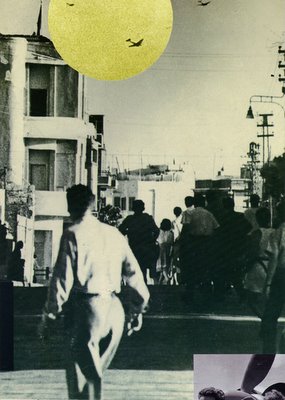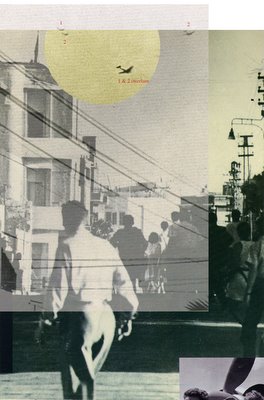Historical footnote
A few weeks ago, the family and I visited our friend Neil and his family for a movie night. (We saw "Stuck on You", and I quite liked it.)
Neil has a history of volunteer work with Israeli children's charities, some of them associated with the Israeli military. One of the gifts he has received is a book called "Shamayim Nakiyim" ("Open Skies") a hardcover volume that celebrates the 40th anniversary of the Israeli Air Force.
I noticed on page three or so, a version of a photo I already had in my 101 Squadron collection, a photograph of Modi Alon in his S-199 as he closes in on one of the first two Israeli air-to-air kills on June 3, 1948. The photo in "Shamayim Nakiyim" shows Alon chasing both the Dakota bombers he shot down that afternoon. Unfortunately, some miscreant graphic artist marred the image in the book with a large yellow circle.
Thinking that the second bomber was cropped out of the photo I already had, I thought I could scan the image from the book and eliminate the yellow in Photoshop with some layering of the two images.
Here's the book photo:

You can compare to the other photo, linked above.
I layered it with my photo as I prepared to "fix" the yellow. I discovered something surprising. These are the not the same photos. The buildings, although both occupy the left side of the frame, are not the same building. These photos came from two different positions in Tel Aviv.
Here is the layered composite. The numeral 1 marks the position of aircraft in the photo I previously had. The numeral 2 marks the aircraft in the "Shamayim Nakiyim" photo.

The Dakota bomber Alon chases lies in identical aspect in the two photos, and Alon himself is also in more or less the same relationship to it.
But which photo came first, and what happened to the leading Dakota? There's enough room for it to appear in photo 1.
Alon is closer to his victim in photo 2, so it's probably the second photo chronologically.
The trailing Dakota and Alon are at lower altitude than the leading Dakota. I suspect the Dakota is (foolishly) trying to dive away from the S-199. You gain speed in a dive, and so I would guess that the chase has caught up with the leading Dakota by the time the second photo is snapped.
Time for some cocktail-napkin math. The Dakota is 28.64 pixels long and 64.5 feet long in life. That's a ratio of 0.4440. The S-199 is 12.31 pixels long and 29.3 feet in life, a ratio of 0.4197. I'd have preferred a closer ratio, but perspective and optics may prevent that. Let's average the two ratios to get 0.4335 as a useful compromise.
Photo 1 has a separation between S-199 and Dakota of 121.06 pixels = 279 feet. Photo 2 shows the gap to be 110.80 pixels, which converts to 256 feet. That's very close, kids, and should serve to warn you not to go bombing without a tailgunner. A more typical attack in these aircraft would take place 200-300 yards out, nearly three times the distance.
Look like I'll have something else to revise in my "101" screenplay. If y'all nag me enough, I can post my screenplay version of this very attack.
Neil has a history of volunteer work with Israeli children's charities, some of them associated with the Israeli military. One of the gifts he has received is a book called "Shamayim Nakiyim" ("Open Skies") a hardcover volume that celebrates the 40th anniversary of the Israeli Air Force.
I noticed on page three or so, a version of a photo I already had in my 101 Squadron collection, a photograph of Modi Alon in his S-199 as he closes in on one of the first two Israeli air-to-air kills on June 3, 1948. The photo in "Shamayim Nakiyim" shows Alon chasing both the Dakota bombers he shot down that afternoon. Unfortunately, some miscreant graphic artist marred the image in the book with a large yellow circle.
Thinking that the second bomber was cropped out of the photo I already had, I thought I could scan the image from the book and eliminate the yellow in Photoshop with some layering of the two images.
Here's the book photo:

You can compare to the other photo, linked above.
I layered it with my photo as I prepared to "fix" the yellow. I discovered something surprising. These are the not the same photos. The buildings, although both occupy the left side of the frame, are not the same building. These photos came from two different positions in Tel Aviv.
Here is the layered composite. The numeral 1 marks the position of aircraft in the photo I previously had. The numeral 2 marks the aircraft in the "Shamayim Nakiyim" photo.

The Dakota bomber Alon chases lies in identical aspect in the two photos, and Alon himself is also in more or less the same relationship to it.
But which photo came first, and what happened to the leading Dakota? There's enough room for it to appear in photo 1.
Alon is closer to his victim in photo 2, so it's probably the second photo chronologically.
The trailing Dakota and Alon are at lower altitude than the leading Dakota. I suspect the Dakota is (foolishly) trying to dive away from the S-199. You gain speed in a dive, and so I would guess that the chase has caught up with the leading Dakota by the time the second photo is snapped.
Time for some cocktail-napkin math. The Dakota is 28.64 pixels long and 64.5 feet long in life. That's a ratio of 0.4440. The S-199 is 12.31 pixels long and 29.3 feet in life, a ratio of 0.4197. I'd have preferred a closer ratio, but perspective and optics may prevent that. Let's average the two ratios to get 0.4335 as a useful compromise.
Photo 1 has a separation between S-199 and Dakota of 121.06 pixels = 279 feet. Photo 2 shows the gap to be 110.80 pixels, which converts to 256 feet. That's very close, kids, and should serve to warn you not to go bombing without a tailgunner. A more typical attack in these aircraft would take place 200-300 yards out, nearly three times the distance.
Look like I'll have something else to revise in my "101" screenplay. If y'all nag me enough, I can post my screenplay version of this very attack.




0 Comments:
Post a Comment
<< Home